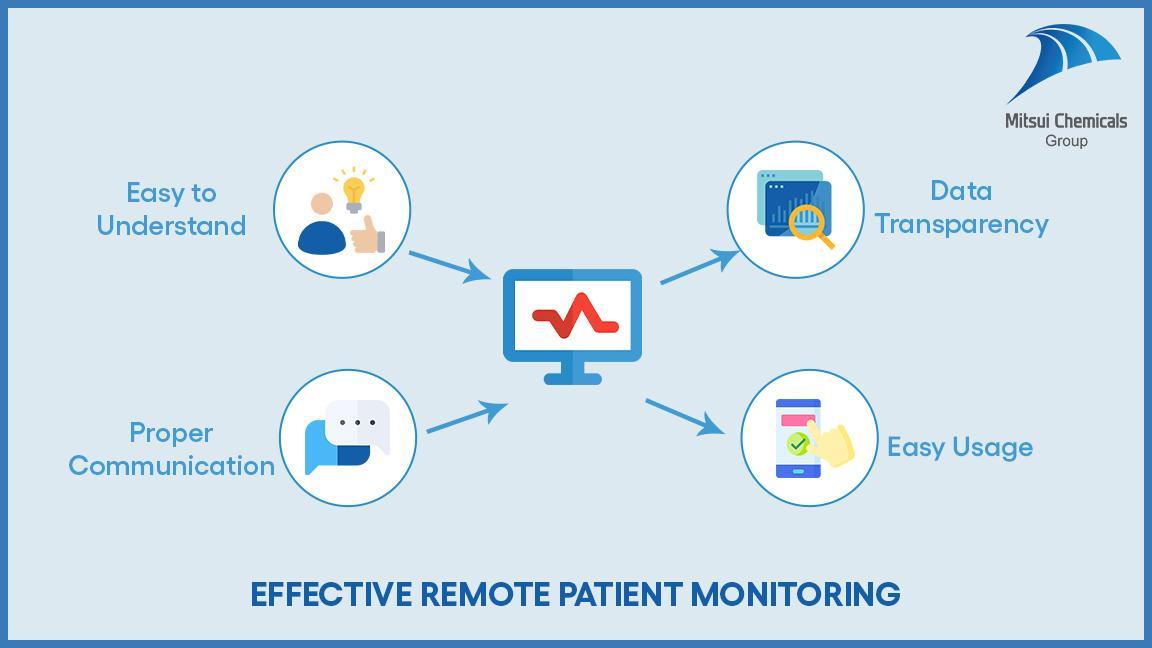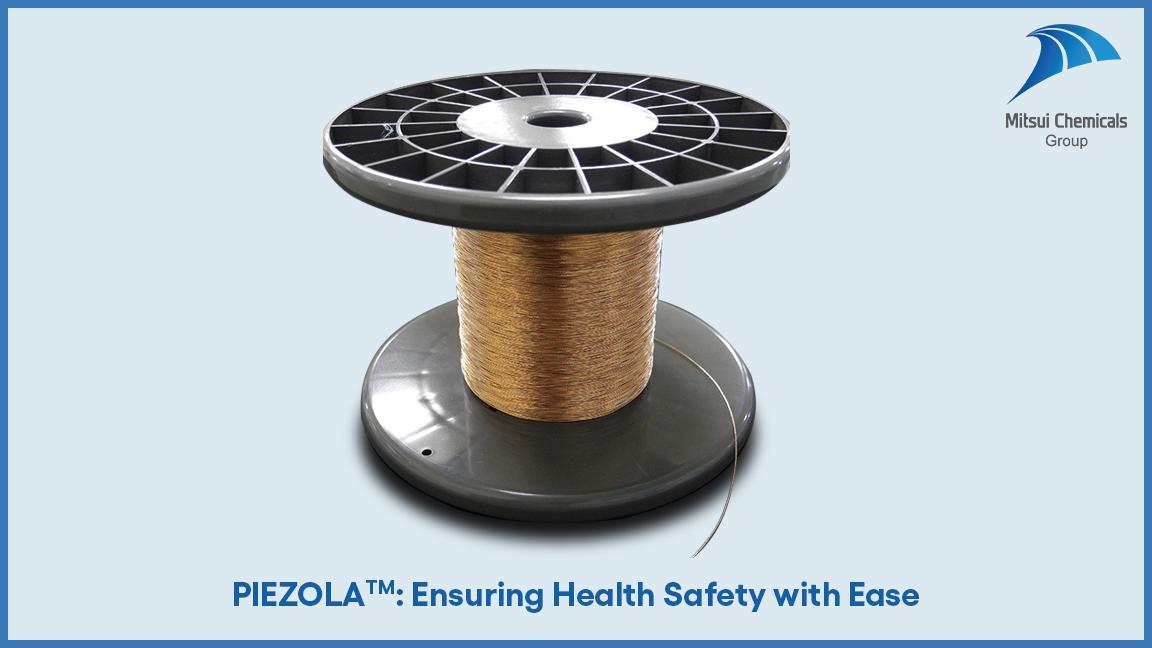Key Considerations for Effective Remote Patient Monitoring
Mitsui Chemicals India Blog Series
2022.07.18
Mitsui Chemicals India Pvt. Ltd.
The healthcare industry benefits immensely from Remote Patient Monitoring RPM systems. It facilitates caregivers and patients in ensuring quality medical assistance. However, certain factors play a key role in evaluating the effectiveness of digital caregiving techniques.
Read further to know more insights about effective remote patient monitoring.
Why rely on Remote Patient Monitoring?
Technological advancements aid numerous problems in the medical industry. Remote patient monitoring technology helps in supervising and managing health digitally. It provides statistical accuracy along with timely intervention in case of emergencies.
Caregivers and patients rely on remote patient monitoring systems for various reasons, such as:
1. Accessibility:
Health check-ups are available at every location, including remote areas. Mobility of medical assistance allows patients to monitor their health manually at home. It also saves the excessive expense of hospital visits for patients with chronic diseases.
2. Lowers caregiver’s workload:
Looking after several patients simultaneously without external support increases the risk of errors and burnout. RPM allows them to monitor patients and maintain organized data records. Additionally, the motion-sensing devices help monitor the patient's response to treatment precisely, which remains unnoticed by the naked eye.
3. Versatile applications:
RPM technology applies to various peripheral devices (such as smartwatches, glucometers, stethoscopes, pulse oximeters, etc.). Bulky machines are unsuitable for use in personal spaces like home/offices, and especially while traveling, it becomes most difficult to track health status. In such instances, RPM allows full-time personalized access to medical surveillance.
4. Hygiene assurance:
After the worldwide COVID-19 pandemic, consciousness about social distancing and contactless services has risen considerably. Keeping minimum physical contact with the patient is also mandatory due to the risk of infections and disease transmission. RPM eliminates the scope of direct physical contact and thus, supports sanitization and hygienic medical treatment.
How to Ensure Effective Patient Monitoring?

RPM enables personalized medical care facilities, which benefits the patients and caregivers. It has its benefits, but it is up to the users to ensure its effectiveness and efficiency. Keeping up with the technology is vain if it gives insufficient outcomes.
RPM can be fully effective only when the following key considerations are ascertained:
1. Transparency of data:
Digital health trackers record physiological parameters (such as blood glucose levels, heart rate, pulse rate, etc.). The recorded data is transmitted to the patient and caregiver.
Hence, the complete information about health status, recovery rate, etc., is shared with both ends. The entire disclosure of reports helps build a trusting relationship between the patient and their caregivers.
2. Easy to use:
Technology is a boon only if it does not get too complicated to use. Users are more likely to prefer easy-to-use RPM devices because it gives them quick access to health tracker and records.
If one has to go through a complex method of inserting details manually repeatedly, it defeats the purpose of "easy" healthcare. Hence, the user interface in devices must be kept simple.
3. Easy to understand:
Medical terminology is often hard to understand for non-medical background people. Mere transparency of data is insignificant if the user is unable to decipher what the reports are directly to. The statistics shown through the RPM must be self-explanatory. It also attracts users from every age group and background.
4. Proper communication between caregiver and patient:
RPM measures the physiological parameters and digitally evaluates the patient's overall health. However, the caregivers and patients must communicate with every health prospect for proper treatment.
Secrecy of relevant information leads to errors in treatments which can worsen the problem rather than cure it. In such cases, the effectiveness of RPM is insubstantial. It also poses risks to the patient's health and life.
Mitsui Chemicals India: Designing Solutions for Your Health
At Mitsui Chemicals India, we have envisioned a safe and healthy future. It is possible only when people remain healthy. With this motive, we continually design solutions that help society maintain a healthy life.
Our healthcare domain consists of solutions aimed at benefiting medical services. Considering the advantages and use of RPM in the industry, we have designed PiezolaTM, a piezoelectric effect-based motion sensing-based technology for RPM systems. It facilitates healthcare in many ways by increasing RPM effectiveness.
It lowers the risk of errors in treating patients with prompt and precise data. It detects every slight movement and alerts the caregiver immediately. These features make health supervision and motion-sensing exceptionally easy and reliable.
PiezolaTM: Features and Advantages

The prime characteristics that distinguish PiezolaTM from the other conventional RPM systems are as follows:
1. Tension sensing:
PiezolaTM enables detection of ultrasonic vibrations. It captures any movement (such as a change in strain, pressure, and impact). It enables the caregiver to observe the patient's treatment response in due time and accurately.
2. High sensitivity:
While other RPM systems frequently fail to pinpoint the area of movement, PiezolaTM promises utmost precision. It not only recognizes the movements but also detects the location of activity. This also helps in reducing the risk of accidental damage due to unpredicted movements.
3. Easy connection:
It is designed from a user-friendly perspective. It easily fits various 3D shapes and sizes. The slim design provides flexibility and is adaptable for use in different devices. It is easy for users to use by connecting it to wearable and watchable sensors.
4. Low noise:
Patient monitoring and motion sensing systems are usually noisy, especially those used in hospitals. It disturbs the atmosphere and keeps the patients from taking proper rest. PiezolaTM exhibits minimum sound and enables the caregivers to monitor patients with the least external inference. It also provides the patient with a comfortable resting space.
Our solutions are strictly directed to improving quality of life (QOL) in society through our Rose ValuesTM benchmark. Our standardized solutions are focused on facilitating society with access to fundamental services. Eventually, it contributes to our goal of building a healthy society.
But Health Comes First!
Medical safety is critical in ascertaining a healthy lifestyle. Fitness must be prioritized to avoid health issues in the future. Remote patient monitoring helps people to lead a healthy life with access to medical facilities at all times.
With current style and technology trends, people are more cautious about their health. Some devices like smartwatches are compact and even provide a daily health-check report to the user. It prompts them to follow a fitness routine as well.
A healthy life is a key to a happy future. The assurance of early and all-time access to medical care also reduces psychological stress. Especially for senior citizens who live alone or require constant health surveillance, RPM has unparalleled advantages.
RPM gives you the prospect of accessing healthcare at all times to protect you against avoidable problems. It helps in the early detection and intervention of health problems. Hence, RPM enables you to live a healthy and stress-free life.
Contact us to install our solutions for your health safety, assurance, and care.
